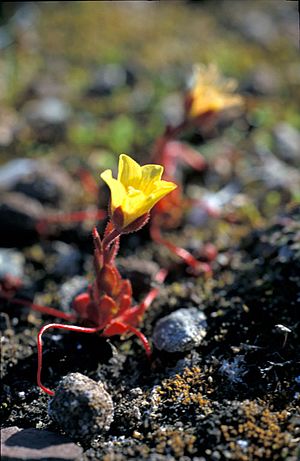Whiplash saxifrage facts for kids
Quick facts for kids Whiplash saxifrage |
|
|---|---|
 |
|
| Saxifraga flagellaris flowering stem | |
| Scientific classification | |
| Genus: |
Saxifraga
|
| Species: |
flagellaris
|
The whiplash saxifrage (Saxifraga flagellaris) is a small, interesting plant. It grows in very cold places around the world. You can find it in the high Arctic regions. It also lives in parts of the northern Rocky Mountains and Norway. This plant is not very common. It is sometimes called the spider saxifrage. Some people might even call it "spider plant." However, the name "spider plant" usually means a different plant. That plant is called Chlorophytum comosum.
Contents
About the Whiplash Saxifrage
What's in a Name?
The whiplash saxifrage has a few nicknames. People sometimes call it the spider saxifrage. This is because it sends out long, thin stems. These stems look a bit like spider legs. They also have little plantlets at their ends. These plantlets can grow into new plants.
Its Plant Relatives
There is another plant that looks very similar. It is called the broadsepal saxifrage (Saxifraga platysepala). For a while, scientists thought it was the same plant. Then they decided it was a separate species. Later, they changed their minds again. Now, it is often considered a subspecies. This means it is a close relative of the whiplash saxifrage. The broadsepal saxifrage grows in places like Greenland and Alaska.
What it Looks Like
The whiplash saxifrage has single stems. These stems stand straight up. They are usually 3 to 10 centimeters tall. That's about 1 to 4 inches. The plant has many leaves at its base. These leaves form a tight circle, like a rose. Long, thin runners grow out from this circle of leaves. These runners have small plantlets at their ends. The plantlets can take root and grow. The leaves also have tiny, sticky hairs on their edges.
Each stem usually has one flower at the top. Sometimes, it has two flowers. The flowers are bright golden yellow. Their petals are much longer than the green parts underneath. The whole plant often has a reddish color.
Where it Grows
This plant likes moist places. You can find it growing on gravel. It also grows in soft moss carpets. Even though it is rare, it is not in danger of disappearing.
Who Described It?
The whiplash saxifrage was first described by a scientist. His name was Carl Ludwig Willdenow. Other scientists sometimes used its name for the broadsepal saxifrage.
Images for kids
See also
 In Spanish: Saxifraga flagellaris para niños
In Spanish: Saxifraga flagellaris para niños


